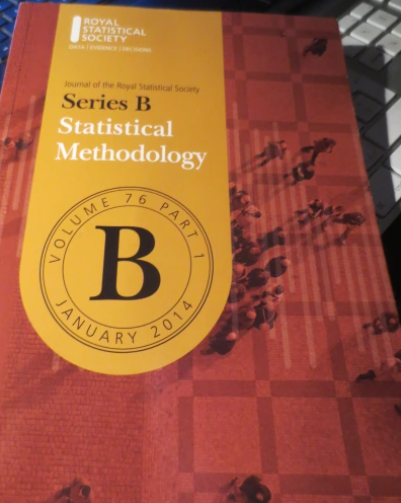Two-way dynamic factor models for high-dimensional matrix-valued time series
IF 3.1
1区 数学
Q1 STATISTICS & PROBABILITY
Journal of the Royal Statistical Society Series B-Statistical Methodology
Pub Date : 2023-08-24
DOI:10.1093/jrsssb/qkad077
引用次数: 0
Abstract
Abstract In this article, we introduce a two-way dynamic factor model (2w-DFM) for high-dimensional matrix-valued time series and study some of the basic theoretical properties in terms of identifiability and estimation accuracy. The proposed model aims to capture separable and low-dimensional effects of row and column attributes and their correlations across rows, columns, and time points. Complementary to other dynamic factor models for high-dimensional data, the 2w-DFM inherits the dimension-reduction feature of factor models but assumes additive row and column factors for easier interpretability. We provide conditions to ensure model identifiability and consider a quasi-likelihood based two-step method for parameter estimation. Under an asymptotic regime where the size of the data matrices as well as the length of the time series increase, we establish that the estimators achieve the optimal rate of convergence and are asymptotically normal. The asymptotic properties are reaffirmed empirically through simulation studies. An application to air quality data in Chinese cities is given to illustrate the merit of the 2w-DFM.高维矩阵值时间序列的双向动态因子模型
摘要本文引入了高维矩阵值时间序列的双向动态因子模型(2w-DFM),并从可辨识性和估计精度方面研究了该模型的一些基本理论性质。该模型旨在捕获行和列属性的可分离和低维效应,以及它们在行、列和时间点之间的相关性。作为其他用于高维数据的动态因子模型的补充,2w-DFM继承了因子模型的降维特性,但为了更容易解释,它假设了行和列因子的相加性。我们提供了保证模型可辨识性的条件,并考虑了一种基于准似然的两步参数估计方法。在数据矩阵的大小和时间序列的长度都增加的渐近状态下,我们证明了估计量达到最优收敛速率并且渐近正态。通过仿真研究,对其渐近性质进行了实证验证。以中国城市空气质量数据为例,说明了2w-DFM的优点。
本文章由计算机程序翻译,如有差异,请以英文原文为准。
求助全文
约1分钟内获得全文
求助全文
来源期刊
CiteScore
8.80
自引率
0.00%
发文量
83
审稿时长
>12 weeks
期刊介绍:
Series B (Statistical Methodology) aims to publish high quality papers on the methodological aspects of statistics and data science more broadly. The objective of papers should be to contribute to the understanding of statistical methodology and/or to develop and improve statistical methods; any mathematical theory should be directed towards these aims. The kinds of contribution considered include descriptions of new methods of collecting or analysing data, with the underlying theory, an indication of the scope of application and preferably a real example. Also considered are comparisons, critical evaluations and new applications of existing methods, contributions to probability theory which have a clear practical bearing (including the formulation and analysis of stochastic models), statistical computation or simulation where original methodology is involved and original contributions to the foundations of statistical science. Reviews of methodological techniques are also considered. A paper, even if correct and well presented, is likely to be rejected if it only presents straightforward special cases of previously published work, if it is of mathematical interest only, if it is too long in relation to the importance of the new material that it contains or if it is dominated by computations or simulations of a routine nature.

 求助内容:
求助内容: 应助结果提醒方式:
应助结果提醒方式:


